Event Review: International Symposium “Reframing Mass Violence: Social Memories and Human Rights in Post-Communist Europe”
(IAS Collaborative)
March 4-6, 2015
An international symposium on “Contested Past, Contested Present: Social Memories and Human Rights in Post-Communist Europe” took place at the University of Minnesota, Twin Cities on March 4-6. It was organized by the IAS Collaborative “Reframing Mass Violence”, and sponsored by the Human Rights Program and the Center for Holocaust and Genocide Studies, among other supporters.
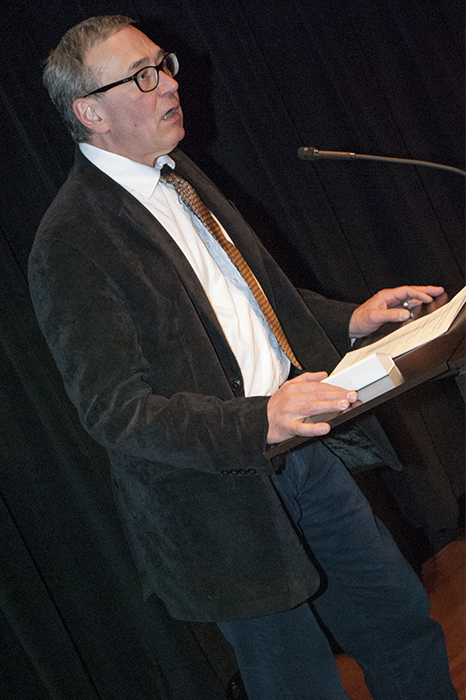 The symposium opened with akeynote lecture by Prof. John-Paul Himka , who spoke about the reception of the Holocaust in post-Communist Europe, especially its legacies in Poland and Ukraine. OnThursday and Friday, sessions covered different aspects of contested memories in post-Communist European countries, from depictions in theater, museums, and film, to transitional justice policies, and the current conflict in the Ukraine. The presentations and ensuing discussions illustrated that the past of post-Communist states remains, indeed, a contested space, negotiating narratives of rising nationalism, victimhood, responsibility, retribution and rehabilitation.
The symposium opened with akeynote lecture by Prof. John-Paul Himka , who spoke about the reception of the Holocaust in post-Communist Europe, especially its legacies in Poland and Ukraine. OnThursday and Friday, sessions covered different aspects of contested memories in post-Communist European countries, from depictions in theater, museums, and film, to transitional justice policies, and the current conflict in the Ukraine. The presentations and ensuing discussions illustrated that the past of post-Communist states remains, indeed, a contested space, negotiating narratives of rising nationalism, victimhood, responsibility, retribution and rehabilitation.
Several themes emerged as central to the discussion of post-Communist memory. First, one theme highlighted the tension, but also interaction between a multiplicity of vernacular memories and often more hegemonic, official ones. Dr. Lars Breuer addressed this in the German and Polish context, as categories of perpetrator and victim appear fluid, and memories multidirectional. Prof. Matti Jutila also focused on challenging interpretations of the past by examining the film “The Soviet Story”. He argued that the film illustrates the “Double Genocide” thesis, which seeks to posit Soviet atrocities on par, if not as exceeding those committed during the Holocaust, and asked how might it be possible to criticize the political use of mass atrocities without denying or downplaying their significance.
The second key theme was the potentiality of creative spaces to deal with past atrocities, but also their limitations. Prof. Sarah Wagner addressed this in her talk about Srebrenica, noting that parallel sites of commemoration exist in the space, symbolizing the divided publics not in conversation with one another. The potentiality of creative spaces as redemptive was also highlighted during the last session of the symposium, where Prof. Michal Kobialka presented on a 1944 staging of “The Return of Odysseus” by Tadeusz Kantor in a bomb-damaged room in Krakow as a radical event, bringing into question the distinction between being and appearance, use value and uselessness, and the role of art as autonomous. Referencing a more contemporary context, Margarita Kompelmakher spoke about the Belarus Free Theater’s performance as one of a human rights paradigm, aiming to be universal, but also limited by the very explicit body it uses to make its point.
The third theme was that of transition, justice and rehabilitation. Prof. Jelena Subotic spoke about the ways a mythologized Communist past shapes how former Yugoslav states imagine their future, at times building on problematic and nationalist pre-WWII narratives and mechanistic assessments of success by ICTY standards. Thomas Wolfe questioned the 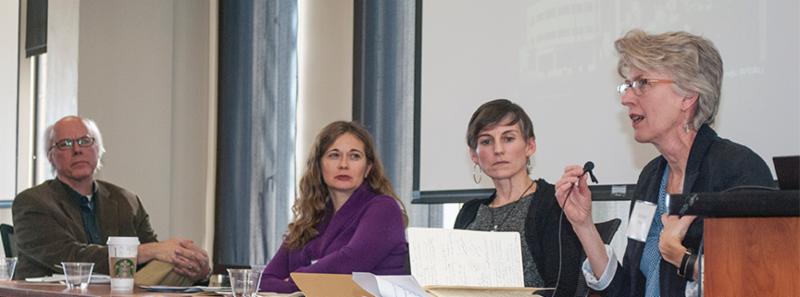 nature of the field of transitional justice. Its assumptions, its philosophical sources and allegiances, its methodological orientations, and most of all, its understanding of how the past exists in, living through the present. Dr. Ryan Molz addressed the lustration policies in Macedonia, Croatia and Serbia, arguing that each of the states had a differing level of implementation of this vetting process due to internal factors, while external factors, such as the international community, have largely been unsupportive of lustration policies. Later, Prof. Adam Czarnota addressed the tension between a demand for formal “rule of law” in countries in transition and the realities of lived memory and informal rule of law already existing in the states. Czarnota noted that there is often a “supply of law”, but no matching demand in transitional contexts. Finally, Prof. Nadya Nedelsky spoke about Slovakia’s struggle with its past, pointing out that societal and academic discourse often do not intertwine on the ground, leading to deeply problematic issues, such as the downplaying of the Nazi-aligned state of the 1930s.
nature of the field of transitional justice. Its assumptions, its philosophical sources and allegiances, its methodological orientations, and most of all, its understanding of how the past exists in, living through the present. Dr. Ryan Molz addressed the lustration policies in Macedonia, Croatia and Serbia, arguing that each of the states had a differing level of implementation of this vetting process due to internal factors, while external factors, such as the international community, have largely been unsupportive of lustration policies. Later, Prof. Adam Czarnota addressed the tension between a demand for formal “rule of law” in countries in transition and the realities of lived memory and informal rule of law already existing in the states. Czarnota noted that there is often a “supply of law”, but no matching demand in transitional contexts. Finally, Prof. Nadya Nedelsky spoke about Slovakia’s struggle with its past, pointing out that societal and academic discourse often do not intertwine on the ground, leading to deeply problematic issues, such as the downplaying of the Nazi-aligned state of the 1930s.
The symposium also held a session on the Ukraine conflict, where professors John-Paul Himka, George O. Liber and J. Brian Atwood addressed the different aspects of the current events. Himka spoke about the role of the regional specifics of Ukraine, and historical differences between them, while Liber addressed Vladimir Putin’s response to the Ukrainian Revolution of 2013-2015 and Russia’s current aggressive foreign policy in the region. Atwood provided an informative view on the current crisis from a U.S. perspective, based on many years of experience in various state institutions, including USAID.
Overall, the event foregrounded issues of how long a transition lasts, what are ways contested pasts are conceptualized and dealt with, legally, commemoratively, and artistically, and how memories can be and are at times used for political purposes. The symposium also highlighted a need to balance contested memories, interpretations of the past with long-term policies that are not merely cosmetic and mechanistic, but often demand a true reevaluation of a country’s history. However, this demands interest and a willingness to do so by the communities in the states themselves. Arguably, the race for EU accession and externally shaped Transitional Justice policies may have resulted in speedy formal establishment of institutions to this effect, but equally seems to have in some instances created a space for hegemonic and reductionist narratives to take hold.
(Full video recordings of all sessions available here, here, and here.)
Arta Ankrava holds an MA in Social Anthropology from Goldsmiths, University of London and is currently a PhD candidate in Sociology at the University of Minnesota. She is interested in diasporic identity, transnationalism, and collective memory. Arta is working on a dissertation about anti-Communism in the Latvian American exile community during the Cold War and through the collapse of the USSR. It is based on her research in the Latvian American Periodicals Collection at the Immigration History Research Center, University of Minnesota.
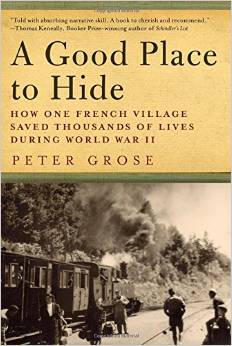

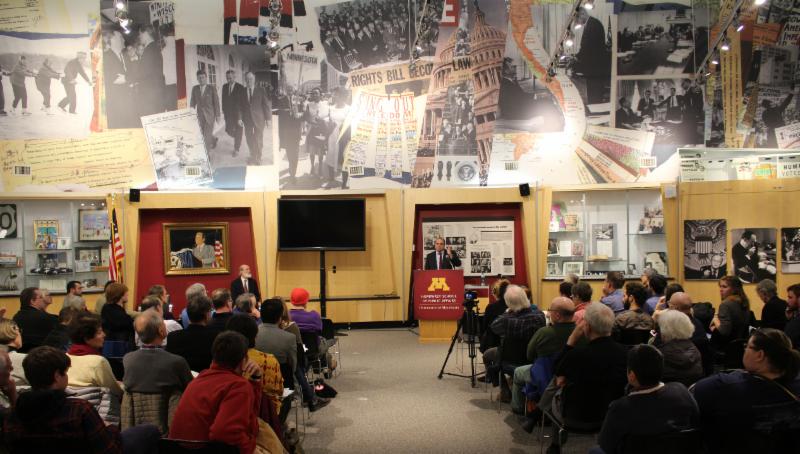 The three-day program was opened by the Arsham and Charlotte Ohanessian Lecture, also serving as keynote for the international student conference, delivered by Professor Bedross Der Matossian, University of Nebraska-Lincoln. His talk was titled
The three-day program was opened by the Arsham and Charlotte Ohanessian Lecture, also serving as keynote for the international student conference, delivered by Professor Bedross Der Matossian, University of Nebraska-Lincoln. His talk was titled 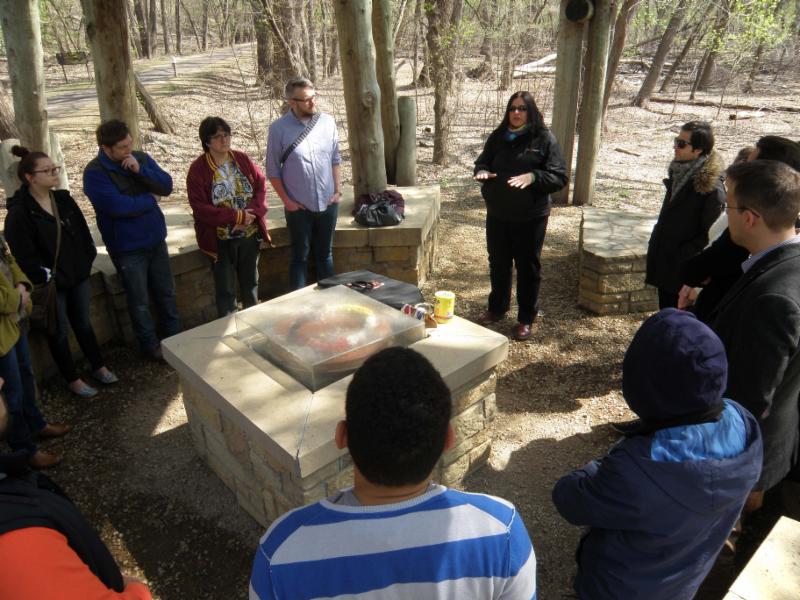 The discussions continued the next morning at Ft. Snelling State Park, where Professor Iyekiyapiwin Darlene St. Clair, St. Cloud State University, led a tour of Dakota sites and history connected to both the genesis and genocide of the Dakota people: “Bdote” is the confluence of the Minnesota and Mississippi Rivers, the sacred site of Dakota creation stories and the location of Fort Snelling, where many Dakota were imprisoned and died in in the 1860s.
The discussions continued the next morning at Ft. Snelling State Park, where Professor Iyekiyapiwin Darlene St. Clair, St. Cloud State University, led a tour of Dakota sites and history connected to both the genesis and genocide of the Dakota people: “Bdote” is the confluence of the Minnesota and Mississippi Rivers, the sacred site of Dakota creation stories and the location of Fort Snelling, where many Dakota were imprisoned and died in in the 1860s.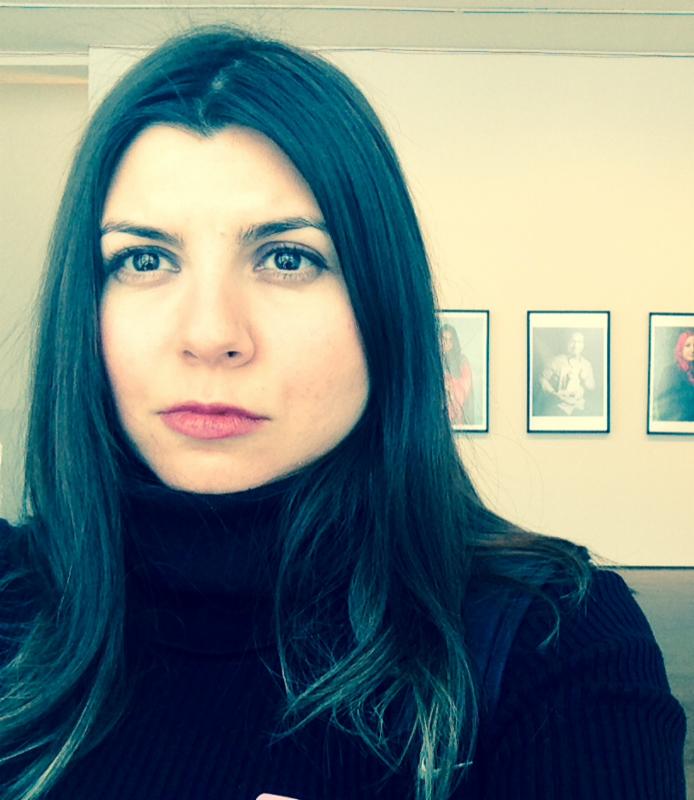 Yagmur Karakaya is a PhD student in Sociology at the University of Minnesota. She is interested in collective memory, popular culture and narratives of history. Yagmur is currently working on her dissertation project on Ottomania, which focuses on contemporary interest in the Ottoman past in Turkey. She is interested in how different groups of minorities engage with the ways in which Ottoman past is recalled and how they situate themselves in this narrative. During her Badzin Graduate Fellowship year, she will focus on the commemoration of the Holocaust in Turkey, and the relative silence on the Armenian genocide situating both of these phenomena in the current political interest in the Ottoman past. This project will engage with current debates regarding memorialization and denial in the field of Holocaust and genocide studies within the context of Turkey. She will be focusing on two major non-Muslim minorities in Turkey: the Jewish and Armenian population, conducting interviews with the members.
Yagmur Karakaya is a PhD student in Sociology at the University of Minnesota. She is interested in collective memory, popular culture and narratives of history. Yagmur is currently working on her dissertation project on Ottomania, which focuses on contemporary interest in the Ottoman past in Turkey. She is interested in how different groups of minorities engage with the ways in which Ottoman past is recalled and how they situate themselves in this narrative. During her Badzin Graduate Fellowship year, she will focus on the commemoration of the Holocaust in Turkey, and the relative silence on the Armenian genocide situating both of these phenomena in the current political interest in the Ottoman past. This project will engage with current debates regarding memorialization and denial in the field of Holocaust and genocide studies within the context of Turkey. She will be focusing on two major non-Muslim minorities in Turkey: the Jewish and Armenian population, conducting interviews with the members.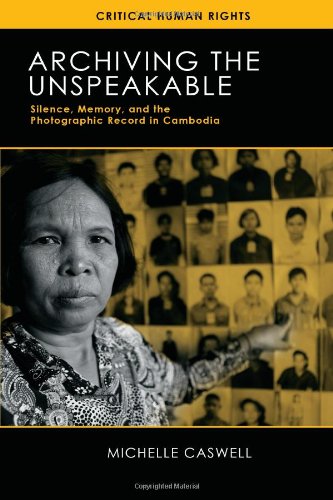 Roughly 1.7 million people died in Cambodia from untreated disease, starvation, and execution during the Khmer Rouge reign of less than four years in the late 1970s. The regime’s brutality has come to be symbolized by the multitude of black-and-white mug shots of prisoners taken at the notorious Tuol Sleng prison, where thousands of “enemies of the state” were tortured before being sent to the Killing Fields. In Archiving the Unspeakable, Michelle Caswell traces the social life of these photographic records through the lens of archival studies and elucidates how, paradoxically, they have become agents of silence and witnessing, human rights and injustice as they are deployed at various moments in time and space. From their creation as Khmer Rouge administrative records to their transformation beginning in 1979 into museum displays, archival collections, and databases, the mug shots are key components in an ongoing drama of unimaginable human suffering.
Roughly 1.7 million people died in Cambodia from untreated disease, starvation, and execution during the Khmer Rouge reign of less than four years in the late 1970s. The regime’s brutality has come to be symbolized by the multitude of black-and-white mug shots of prisoners taken at the notorious Tuol Sleng prison, where thousands of “enemies of the state” were tortured before being sent to the Killing Fields. In Archiving the Unspeakable, Michelle Caswell traces the social life of these photographic records through the lens of archival studies and elucidates how, paradoxically, they have become agents of silence and witnessing, human rights and injustice as they are deployed at various moments in time and space. From their creation as Khmer Rouge administrative records to their transformation beginning in 1979 into museum displays, archival collections, and databases, the mug shots are key components in an ongoing drama of unimaginable human suffering.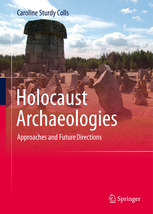 Holocaust Archaeologies: Approaches and Future Directions aims to move archaeological research concerning the Holocaust forward through a discussion of the variety of the political, social, ethical and religious issues that surround investigations of this period and by considering how to address them. It considers the various reasons why archaeological investigations may take place and what issues will be brought to bear when fieldwork is suggested. It presents an interdisciplinary methodology in order to demonstrate how archaeology can (uniquely) contribute to the history of this period. Case examples are used throughout the book in order to contextualize prevalent themes and a variety of geographically and typologically diverse sites throughout Europe are discussed. This book challenges many of the widely held perceptions concerning the Holocaust, including the idea that it was solely an Eastern European phenomena centered on Auschwitz and the belief that other sites connected to it were largely destroyed or are well-known. The typologically, temporally and spatial diverse body of physical evidence pertaining to this period is presented and future possibilities for investigation of it are discussed. Finally, the volume concludes by discussing issues relating to the “re-presentation” of the Holocaust and the impact of this on commemoration, heritage management and education. This discussion is a timely one as we enter an age without survivors and questions are raised about how to educate future generations about these events in their absence.
Holocaust Archaeologies: Approaches and Future Directions aims to move archaeological research concerning the Holocaust forward through a discussion of the variety of the political, social, ethical and religious issues that surround investigations of this period and by considering how to address them. It considers the various reasons why archaeological investigations may take place and what issues will be brought to bear when fieldwork is suggested. It presents an interdisciplinary methodology in order to demonstrate how archaeology can (uniquely) contribute to the history of this period. Case examples are used throughout the book in order to contextualize prevalent themes and a variety of geographically and typologically diverse sites throughout Europe are discussed. This book challenges many of the widely held perceptions concerning the Holocaust, including the idea that it was solely an Eastern European phenomena centered on Auschwitz and the belief that other sites connected to it were largely destroyed or are well-known. The typologically, temporally and spatial diverse body of physical evidence pertaining to this period is presented and future possibilities for investigation of it are discussed. Finally, the volume concludes by discussing issues relating to the “re-presentation” of the Holocaust and the impact of this on commemoration, heritage management and education. This discussion is a timely one as we enter an age without survivors and questions are raised about how to educate future generations about these events in their absence.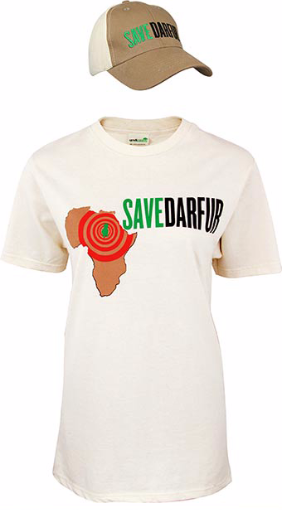 with ‘Save Darfur’ emblazoned on them. Syria, Iraq, Liberia, South Sudan, and Central Africa Republic have overtaken Darfur in the attention sweepstakes in the news. In previous posts I have talked about Compassion Fatigue and the four horsemen of the apocalypse whenever atrocities were covered in the media. However, when is it ok to say enough is enough? When do we, as global citizens, stop shaking our heads and going “tsk tsk, it is so sad what is happening in that country”? These are questions I have asked myself over the past few years. As a graduate student, I have often wondered if my keeping an eye on Darfur is influenced by the fact that my research is in the region. Would it matter as much if my research was on, say, farming practices in Africa? I would like to think it would, if for no reason other than the fact that my country (Kenya) shares a border with South Sudan. I would like to think that whenever I opened the local daily at a coffee shop, or on my way to work in the morning, I would read the news about Darfur and seek out like-minded individuals to try and help in some way, shape or form. What form of help this would be I’m not sure as of yet. So to the question, what have I done for Darfur lately? My honest answer is not as much as I would have liked to do. As Darfur has morphed into a conflict occurring in the shadows (a dreadful prospect) my sense of hopelessness has also increased. What will your answer be?
with ‘Save Darfur’ emblazoned on them. Syria, Iraq, Liberia, South Sudan, and Central Africa Republic have overtaken Darfur in the attention sweepstakes in the news. In previous posts I have talked about Compassion Fatigue and the four horsemen of the apocalypse whenever atrocities were covered in the media. However, when is it ok to say enough is enough? When do we, as global citizens, stop shaking our heads and going “tsk tsk, it is so sad what is happening in that country”? These are questions I have asked myself over the past few years. As a graduate student, I have often wondered if my keeping an eye on Darfur is influenced by the fact that my research is in the region. Would it matter as much if my research was on, say, farming practices in Africa? I would like to think it would, if for no reason other than the fact that my country (Kenya) shares a border with South Sudan. I would like to think that whenever I opened the local daily at a coffee shop, or on my way to work in the morning, I would read the news about Darfur and seek out like-minded individuals to try and help in some way, shape or form. What form of help this would be I’m not sure as of yet. So to the question, what have I done for Darfur lately? My honest answer is not as much as I would have liked to do. As Darfur has morphed into a conflict occurring in the shadows (a dreadful prospect) my sense of hopelessness has also increased. What will your answer be? The symposium opened with a
The symposium opened with a nature of the field of transitional justice. Its assumptions, its philosophical sources and allegiances, its methodological orientations, and most of all, its understanding of how the past exists in, living through the present. Dr. Ryan Molz addressed the lustration policies in Macedonia, Croatia and Serbia, arguing that each of the states had a differing level of implementation of this vetting process due to internal factors, while external factors, such as the international community, have largely been unsupportive of lustration policies. Later, Prof. Adam Czarnota addressed the tension between a demand for formal “rule of law” in countries in transition and the realities of lived memory and informal rule of law already existing in the states. Czarnota noted that there is often a “supply of law”, but no matching demand in transitional contexts. Finally, Prof. Nadya Nedelsky spoke about Slovakia’s struggle with its past, pointing out that societal and academic discourse often do not intertwine on the ground, leading to deeply problematic issues, such as the downplaying of the Nazi-aligned state of the 1930s.
nature of the field of transitional justice. Its assumptions, its philosophical sources and allegiances, its methodological orientations, and most of all, its understanding of how the past exists in, living through the present. Dr. Ryan Molz addressed the lustration policies in Macedonia, Croatia and Serbia, arguing that each of the states had a differing level of implementation of this vetting process due to internal factors, while external factors, such as the international community, have largely been unsupportive of lustration policies. Later, Prof. Adam Czarnota addressed the tension between a demand for formal “rule of law” in countries in transition and the realities of lived memory and informal rule of law already existing in the states. Czarnota noted that there is often a “supply of law”, but no matching demand in transitional contexts. Finally, Prof. Nadya Nedelsky spoke about Slovakia’s struggle with its past, pointing out that societal and academic discourse often do not intertwine on the ground, leading to deeply problematic issues, such as the downplaying of the Nazi-aligned state of the 1930s.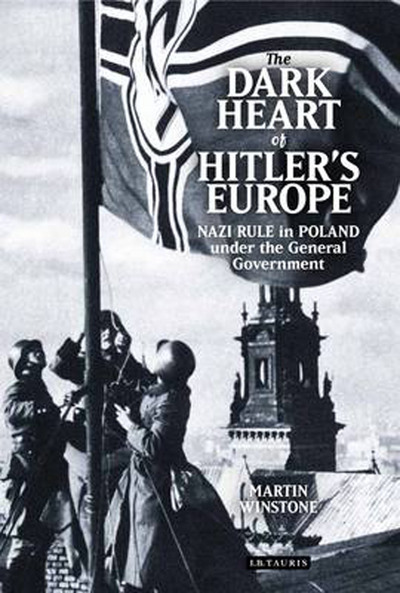 Even amidst the horrors of Nazi rule in Europe, the tragic history of the General Government – the Nazi colony created out of the historic core of Poland, including Warsaw and Krakow, following the German and Soviet invasion of 1939 – stands out. Separate from but ruled by Germany through a brutal and corrupt regime headed by the vain and callous Hans Frank, this was indeed the dark heart of Hitler’s empire. As the principal ‘racial laboratory’ of the Third Reich, the General Government was the site of Aktion Reinhard, the largest killing operation of the Holocaust, and of a campaign of terror and ethnic cleansing against Poles which was intended to be a template for the rest of eastern Europe.
Even amidst the horrors of Nazi rule in Europe, the tragic history of the General Government – the Nazi colony created out of the historic core of Poland, including Warsaw and Krakow, following the German and Soviet invasion of 1939 – stands out. Separate from but ruled by Germany through a brutal and corrupt regime headed by the vain and callous Hans Frank, this was indeed the dark heart of Hitler’s empire. As the principal ‘racial laboratory’ of the Third Reich, the General Government was the site of Aktion Reinhard, the largest killing operation of the Holocaust, and of a campaign of terror and ethnic cleansing against Poles which was intended to be a template for the rest of eastern Europe.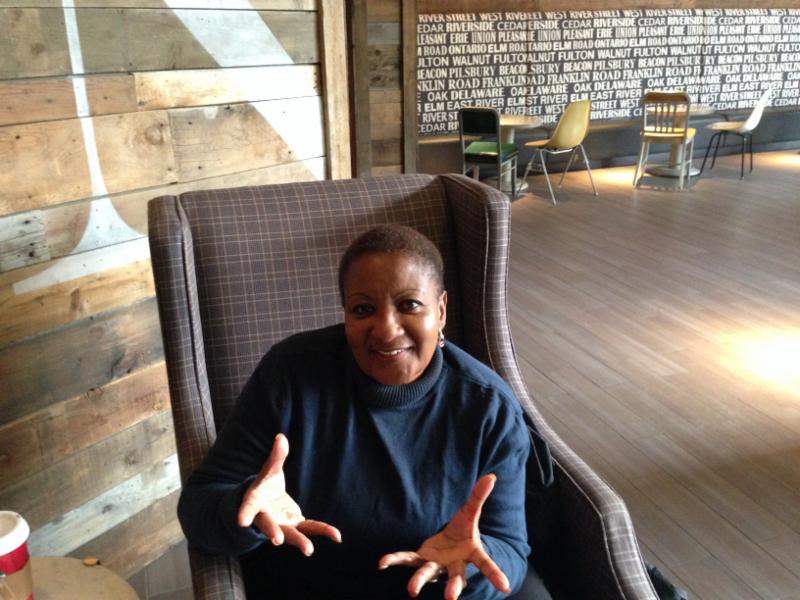 Utjiua Muinjangue is the chairperson of the Ovaherero and Ovambanderu Genocide Foundation. Ms. Muinjangue spoke on behalf of the school of Social Work at the University of Minnesota on the genocide of the Herero on November 10, 2014.
Utjiua Muinjangue is the chairperson of the Ovaherero and Ovambanderu Genocide Foundation. Ms. Muinjangue spoke on behalf of the school of Social Work at the University of Minnesota on the genocide of the Herero on November 10, 2014.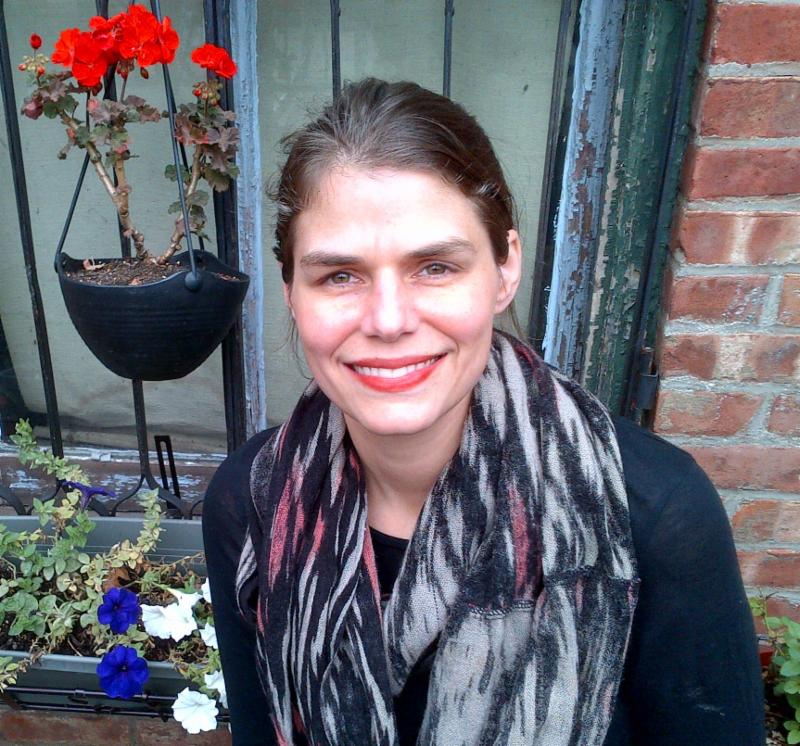 CHGS is pleased to welcome Jennifer Hammer, new program associate in the Institute for Global Studies with special responsibility to support the Center for Holocaust and Genocide Studies and the Center for Austrian Studies. Jennifer completed her degree at the University of Minnesota in Anthropology and Japanese, and has done graduate work in the history of design. Jennifer comes to us from the Department of Communication Studies and has programming and management experience at a number of non-profit organizations including JSTOR, Artstor, and the Minneapolis Institute of Arts.
CHGS is pleased to welcome Jennifer Hammer, new program associate in the Institute for Global Studies with special responsibility to support the Center for Holocaust and Genocide Studies and the Center for Austrian Studies. Jennifer completed her degree at the University of Minnesota in Anthropology and Japanese, and has done graduate work in the history of design. Jennifer comes to us from the Department of Communication Studies and has programming and management experience at a number of non-profit organizations including JSTOR, Artstor, and the Minneapolis Institute of Arts.